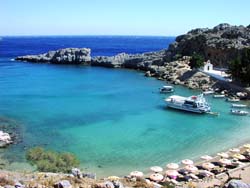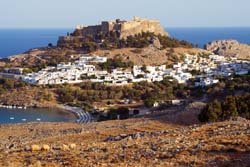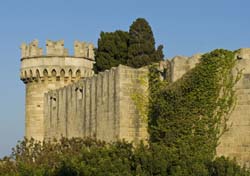[an error occurred while processing this directive]
[an error occurred while processing this directive]
[an error occurred while processing this directive]
[an error occurred while processing this directive]
[an error occurred while processing this directive]
[an error occurred while processing this directive]
[an error occurred while processing this directive]
[an error occurred while processing this directive]
Rhodes island
A quick tour in Rhodes island, Greece
Vacation and accommodation in Greece is a complete Travel Guide for Greece. In Vacation-Greece you will find information on Greek islands and a list of hotels and villas in Dodecanese, studios and apartments for all budgets. Find hotel offers in Dodecanese, see maps and photos of Dodecanese, book flights, ferry tickets, discover Dodecanese, book guided tours and make hotel reservations.

 The largest of the Dodecanese, Rhodes (or Rodos) has become an important regional centre, thanks to its location, climate and natural attractions.
The largest of the Dodecanese, Rhodes (or Rodos) has become an important regional centre, thanks to its location, climate and natural attractions.
It is known as the isle of the Sun. Pindar mentions in one of his Odes that it was born of the union of Helios the sun god and the nymph Rhoda. During antiquity it also bore the names Aithraia, Ophiousa and Telchinis.
It was first inhabited in the Neolithic era. A major milestone in the island's history, which affected the fate of the other Dodecanese as well, was the founding in 700 B.C. of the Dorian Hexapolis, a union of its three cities with Knidos, Halikarnassos and Kos. Its economy and culture continued to flourish until the 3rd century B.C., when it was the predominant power in the Aegean. When, a thousand years later in 1309, it fell into the hands of the Knights of St. John, it became again the centre of power, symbolized by its magnificent mediaeval tomp and the imposing castle and palace of the Grand Masters.
 The island's terrain is in large part fertile with a great variety of vegetation; its highest mountain is Atavyros (1,215 m. asl) in the southwest.
The island's terrain is in large part fertile with a great variety of vegetation; its highest mountain is Atavyros (1,215 m. asl) in the southwest.
The capital, also called Rhodes, occupies the northernmost tip of the island. There are actually three cities in this site - modern, ancient and mediaeval. The modern town has a cosmopolitan character, many late 20th century buildings and hotels. The ancient town, which was founded in 408 B.C. according to plans by Hippodamos of Milesios (the first town planner), started from Monte Smith hill where the acropolis stood and extended as far as what is now the mediaeval city. All that is left of it today is the ruins of the temples of Zeus, Athena Poliados, the Stadium, Gymnasium and the Theatre, which has been restored. The mediaeval city is still surrounded by the high walls erected by the Knights. It is divided by an inner wall into two unequal parts, the smaller Collachio and the larger Burgo or Hora.
 Collachio is further split by the Street of the Knights, both of whose sides are lined with the sombre stone facades of the Inns of the Tongues or nationalities that belonged to the order of the Knights Hospitalers of St. John. At the end of the street stands the palace of the Grand Masters, which today houses a collection of l6th and l7th century furniture and Roman mosaic floors from Kos. The Hospital of the Knights, another of the town's most magnificent buildings, has been converted to the Archaeological Museum. Burgo / Hora lies to the south of Collachio; its walls once enclosed the humbler residences, the marketplace, the Synagogue and Jewish quarter, Orthodox and Catholic churches, public buildings and army barracks.
Collachio is further split by the Street of the Knights, both of whose sides are lined with the sombre stone facades of the Inns of the Tongues or nationalities that belonged to the order of the Knights Hospitalers of St. John. At the end of the street stands the palace of the Grand Masters, which today houses a collection of l6th and l7th century furniture and Roman mosaic floors from Kos. The Hospital of the Knights, another of the town's most magnificent buildings, has been converted to the Archaeological Museum. Burgo / Hora lies to the south of Collachio; its walls once enclosed the humbler residences, the marketplace, the Synagogue and Jewish quarter, Orthodox and Catholic churches, public buildings and army barracks.
 The island abounds in lovely and interesting places to visit, such as the Valley of the Butterflies; the village of Trianda near the site of ancient lalyssos (lalissos) on the top of Filerimos hill, where the l5th century monastery of the same name also stands, along with the ruined temples of Athena and Zeus Poliea in the ancient acropolis; Kameiros (Kamiros) and the ruins of the Dorian city; Kalithea with its thermal baths; Koskinou, Afandou, Faliraki and Rodini.
The island abounds in lovely and interesting places to visit, such as the Valley of the Butterflies; the village of Trianda near the site of ancient lalyssos (lalissos) on the top of Filerimos hill, where the l5th century monastery of the same name also stands, along with the ruined temples of Athena and Zeus Poliea in the ancient acropolis; Kameiros (Kamiros) and the ruins of the Dorian city; Kalithea with its thermal baths; Koskinou, Afandou, Faliraki and Rodini.
But above all don't miss Lindos. The contrast beiween the brilliant white houses and winding lanes of the more recent village built around two crescent beaches and the ancient acropolis towering above it from its austere pinnacle makes for one of the most stunning views in Greece. The temple of Athena Lindia (4th century B.C.) coming gradually into view as you ascend the stairs is a sight never to be forgotten.
Finally, there are splendid beaches all over the island, some af which are equipped with facilities for bathers and equipment for water sports.

 The largest of the Dodecanese, Rhodes (or Rodos) has become an important regional centre, thanks to its location, climate and natural attractions.
The largest of the Dodecanese, Rhodes (or Rodos) has become an important regional centre, thanks to its location, climate and natural attractions. It is known as the isle of the Sun. Pindar mentions in one of his Odes that it was born of the union of Helios the sun god and the nymph Rhoda. During antiquity it also bore the names Aithraia, Ophiousa and Telchinis.
It was first inhabited in the Neolithic era. A major milestone in the island's history, which affected the fate of the other Dodecanese as well, was the founding in 700 B.C. of the Dorian Hexapolis, a union of its three cities with Knidos, Halikarnassos and Kos. Its economy and culture continued to flourish until the 3rd century B.C., when it was the predominant power in the Aegean. When, a thousand years later in 1309, it fell into the hands of the Knights of St. John, it became again the centre of power, symbolized by its magnificent mediaeval tomp and the imposing castle and palace of the Grand Masters.
 The island's terrain is in large part fertile with a great variety of vegetation; its highest mountain is Atavyros (1,215 m. asl) in the southwest.
The island's terrain is in large part fertile with a great variety of vegetation; its highest mountain is Atavyros (1,215 m. asl) in the southwest. The capital, also called Rhodes, occupies the northernmost tip of the island. There are actually three cities in this site - modern, ancient and mediaeval. The modern town has a cosmopolitan character, many late 20th century buildings and hotels. The ancient town, which was founded in 408 B.C. according to plans by Hippodamos of Milesios (the first town planner), started from Monte Smith hill where the acropolis stood and extended as far as what is now the mediaeval city. All that is left of it today is the ruins of the temples of Zeus, Athena Poliados, the Stadium, Gymnasium and the Theatre, which has been restored. The mediaeval city is still surrounded by the high walls erected by the Knights. It is divided by an inner wall into two unequal parts, the smaller Collachio and the larger Burgo or Hora.
 Collachio is further split by the Street of the Knights, both of whose sides are lined with the sombre stone facades of the Inns of the Tongues or nationalities that belonged to the order of the Knights Hospitalers of St. John. At the end of the street stands the palace of the Grand Masters, which today houses a collection of l6th and l7th century furniture and Roman mosaic floors from Kos. The Hospital of the Knights, another of the town's most magnificent buildings, has been converted to the Archaeological Museum. Burgo / Hora lies to the south of Collachio; its walls once enclosed the humbler residences, the marketplace, the Synagogue and Jewish quarter, Orthodox and Catholic churches, public buildings and army barracks.
Collachio is further split by the Street of the Knights, both of whose sides are lined with the sombre stone facades of the Inns of the Tongues or nationalities that belonged to the order of the Knights Hospitalers of St. John. At the end of the street stands the palace of the Grand Masters, which today houses a collection of l6th and l7th century furniture and Roman mosaic floors from Kos. The Hospital of the Knights, another of the town's most magnificent buildings, has been converted to the Archaeological Museum. Burgo / Hora lies to the south of Collachio; its walls once enclosed the humbler residences, the marketplace, the Synagogue and Jewish quarter, Orthodox and Catholic churches, public buildings and army barracks.  The island abounds in lovely and interesting places to visit, such as the Valley of the Butterflies; the village of Trianda near the site of ancient lalyssos (lalissos) on the top of Filerimos hill, where the l5th century monastery of the same name also stands, along with the ruined temples of Athena and Zeus Poliea in the ancient acropolis; Kameiros (Kamiros) and the ruins of the Dorian city; Kalithea with its thermal baths; Koskinou, Afandou, Faliraki and Rodini.
The island abounds in lovely and interesting places to visit, such as the Valley of the Butterflies; the village of Trianda near the site of ancient lalyssos (lalissos) on the top of Filerimos hill, where the l5th century monastery of the same name also stands, along with the ruined temples of Athena and Zeus Poliea in the ancient acropolis; Kameiros (Kamiros) and the ruins of the Dorian city; Kalithea with its thermal baths; Koskinou, Afandou, Faliraki and Rodini. But above all don't miss Lindos. The contrast beiween the brilliant white houses and winding lanes of the more recent village built around two crescent beaches and the ancient acropolis towering above it from its austere pinnacle makes for one of the most stunning views in Greece. The temple of Athena Lindia (4th century B.C.) coming gradually into view as you ascend the stairs is a sight never to be forgotten.
Finally, there are splendid beaches all over the island, some af which are equipped with facilities for bathers and equipment for water sports.
[an error occurred while processing this directive]
[an error occurred while processing this directive]
[an error occurred while processing this directive]